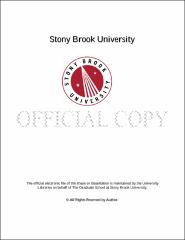| dc.identifier.uri | http://hdl.handle.net/1951/60233 | |
| dc.identifier.uri | http://hdl.handle.net/11401/71054 | |
| dc.description.sponsorship | This work is sponsored by the Stony Brook University Graduate School in compliance with the requirements for completion of degree. | en_US |
| dc.format | Monograph | |
| dc.format.medium | Electronic Resource | en_US |
| dc.language.iso | en_US | |
| dc.publisher | The Graduate School, Stony Brook University: Stony Brook, NY. | |
| dc.type | Dissertation | |
| dcterms.abstract | This study of the relict `Oyster Terrain' in the Peconic Estuary of Long Island, NY using multibeam bathymetry, chirp sonar and sample analysis provides a history of estuarine evolution over thousands of years. More than 10,000 relict oyster reefs are exposed as mounds on the seabed within the Peconic Estuary, with more mounds imaged below the sediment surface. The tops of these relict oyster reefs are at water depths of ~6 m - 18 m and reef thicknesses of up to 6 m suggest active reef building over a few thousand years. At 28 psu, the present estuary is too saline for natural populations of the Eastern Oyster, Crassostrea virginica, to survive although transplanted oysters will grow. Morphological and shell data tell of a time when crowded oyster reefs once dominated the area; however, there has been a natural evolution in the Holocene to an environment where oysters are rare. Shells from relict oyster reefs provide the opportunity for a more detailed environmental reconstruction of this important transition through <super>14<super>C dating and geochemical proxies such as <super>87<super>Sr/<super>86<super>Sr (salinity) and <super>226<super>226 (submarine groundwater discharge). Reefs persisted in the Peconic Estuary despite rising salinities until ~1,350 years ago. Relict shells were compared to modern aquaculture shells grown in Peconic oyster farms. Submarine groundwater discharge seems to have dramatically decreased over time within the estuary according to concentrations of <super>226<super>Ra recorded in several sample shells. Sr isotope measurements indicate past variability in salinity was also captured in the relict shells. The era of abundant oyster reefs ended gradually suggesting that there was a gradual evolution to conditions that did not favor oyster survival. Surprisingly, the oyster reefs were growing in slightly deeper water than we anticipated before dying off. The youngest reefs were in only ~2.5 m of water 1,350 years ago; however, the oldest exposed reef tops we dated would have been active in ~10 m of water some 2,350 years ago. Our results suggest that oysters may have thrived in deeper waters more abundantly in the past than in modern stressed estuaries. | |
| dcterms.available | 2013-05-24T16:38:16Z | |
| dcterms.available | 2015-04-24T14:45:43Z | |
| dcterms.contributor | Flood, Roger D. | en_US |
| dcterms.contributor | Cochran, J. Kirk | en_US |
| dcterms.contributor | Varekamp, Johan C.Black, David E.Cerrato, Robert M. | en_US |
| dcterms.creator | Kinney, Juliet Kinney West | |
| dcterms.dateAccepted | 2013-05-24T16:38:16Z | |
| dcterms.dateAccepted | 2015-04-24T14:45:43Z | |
| dcterms.dateSubmitted | 2013-05-24T16:38:16Z | |
| dcterms.dateSubmitted | 2015-04-24T14:45:43Z | |
| dcterms.description | Department of Marine and Atmospheric Science | en_US |
| dcterms.extent | 369 pg. | en_US |
| dcterms.format | Monograph | |
| dcterms.format | Application/PDF | en_US |
| dcterms.identifier | http://hdl.handle.net/1951/60233 | |
| dcterms.identifier | http://hdl.handle.net/11401/71054 | |
| dcterms.issued | 2012-05-01 | |
| dcterms.language | en_US | |
| dcterms.provenance | Made available in DSpace on 2013-05-24T16:38:16Z (GMT). No. of bitstreams: 1
StonyBrookUniversityETDPageEmbargo_20130517082608_116839.pdf: 41286 bytes, checksum: 425a156df10bbe213bfdf4d175026e82 (MD5)
Previous issue date: 1 | en |
| dcterms.provenance | Made available in DSpace on 2015-04-24T14:45:43Z (GMT). No. of bitstreams: 3
StonyBrookUniversityETDPageEmbargo_20130517082608_116839.pdf.jpg: 1934 bytes, checksum: c116f0e1e7be19420106a88253e31f2e (MD5)
StonyBrookUniversityETDPageEmbargo_20130517082608_116839.pdf.txt: 336 bytes, checksum: 84c0f8f99f2b4ae66b3cc3ade09ad2e9 (MD5)
StonyBrookUniversityETDPageEmbargo_20130517082608_116839.pdf: 41286 bytes, checksum: 425a156df10bbe213bfdf4d175026e82 (MD5)
Previous issue date: 1 | en |
| dcterms.publisher | The Graduate School, Stony Brook University: Stony Brook, NY. | |
| dcterms.subject | multibeam echosounder, oyster reef, paleoceanography, sediment, sub-bottom seismic profile, submarine groundwater discharge | |
| dcterms.subject | Marine geology--Geomorphology--Paleoclimate science | |
| dcterms.title | Evolution of the Peconic Estuary `Oyster Terrain' Long Island, NY | |
| dcterms.type | Dissertation | |

